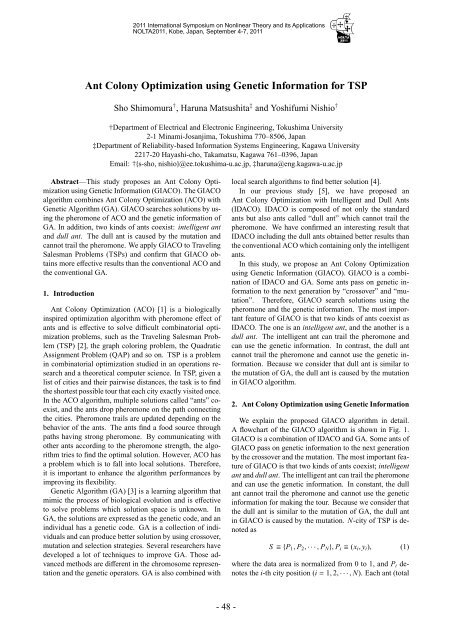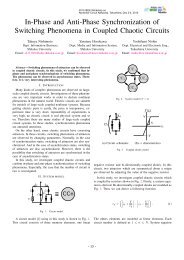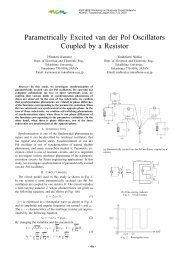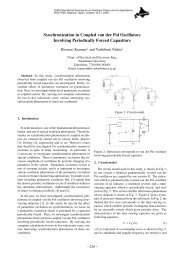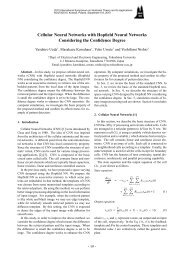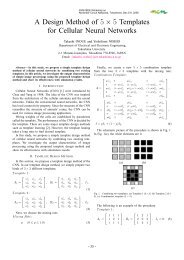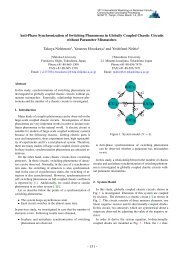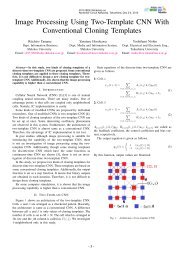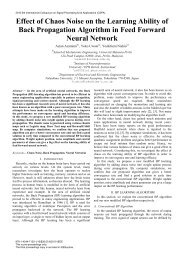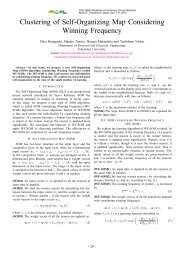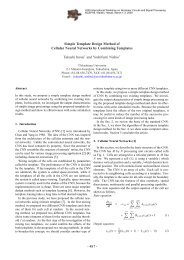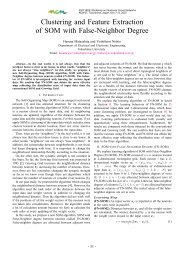Ant Colony Optimization using Genetic Information for TSP
Ant Colony Optimization using Genetic Information for TSP
Ant Colony Optimization using Genetic Information for TSP
Create successful ePaper yourself
Turn your PDF publications into a flip-book with our unique Google optimized e-Paper software.
<strong>Ant</strong> <strong>Colony</strong> <strong>Optimization</strong> <strong>using</strong> <strong>Genetic</strong> <strong>In<strong>for</strong>mation</strong> <strong>for</strong> <strong>TSP</strong><br />
Sho Shimomura † , Haruna Matsushita ‡ and Yoshifumi Nishio †<br />
†Department of Electrical and Electronic Engineering, Tokushima University<br />
2-1 Minami-Josanjima, Tokushima 770–8506, Japan<br />
‡Department of Reliability-based <strong>In<strong>for</strong>mation</strong> Systems Engineering, Kagawa University<br />
2217-20 Hayashi-cho, Takamatsu, Kagawa 761–0396, Japan<br />
Email: †{s-sho, nishio}@ee.tokushima-u.ac.jp, ‡haruna@eng.kagawa-u.ac.jp<br />
Abstract—This study proposes an <strong>Ant</strong> <strong>Colony</strong> <strong>Optimization</strong><br />
<strong>using</strong> <strong>Genetic</strong> <strong>In<strong>for</strong>mation</strong> (GIACO). The GIACO<br />
algorithm combines <strong>Ant</strong> <strong>Colony</strong> <strong>Optimization</strong> (ACO) with<br />
<strong>Genetic</strong> Algorithm (GA). GIACO searches solutions by <strong>using</strong><br />
the pheromone of ACO and the genetic in<strong>for</strong>mation of<br />
GA. In addition, two kinds of ants coexist: intelligent ant<br />
and dull ant. The dull ant is caused by the mutation and<br />
cannot trail the pheromone. We apply GIACO to Traveling<br />
Salesman Problems (<strong>TSP</strong>s) and confirm that GIACO obtains<br />
more effective results than the conventional ACO and<br />
the conventional GA.<br />
1. Introduction<br />
2011 International Symposium on Nonlinear Theory and its Applications<br />
NOLTA2011, Kobe, Japan, September 4-7, 2011<br />
<strong>Ant</strong> <strong>Colony</strong> <strong>Optimization</strong> (ACO) [1] is a biologically<br />
inspired optimization algorithm with pheromone effect of<br />
ants and is effective to solve difficult combinatorial optimization<br />
problems, such as the Traveling Salesman Problem<br />
(<strong>TSP</strong>) [2], the graph coloring problem, the Quadratic<br />
Assignment Problem (QAP) and so on. <strong>TSP</strong> is a problem<br />
in combinatorial optimization studied in an operations research<br />
and a theoretical computer science. In <strong>TSP</strong>, given a<br />
list of cities and their pairwise distances, the task is to find<br />
the shortest possible tour that each city exactly visited once.<br />
In the ACO algorithm, multiple solutions called “ants” coexist,<br />
and the ants drop pheromone on the path connecting<br />
the cities. Pheromone trails are updated depending on the<br />
behavior of the ants. The ants find a food source through<br />
paths having strong pheromone. By communicating with<br />
other ants according to the pheromone strength, the algorithm<br />
tries to find the optimal solution. However, ACO has<br />
a problem which is to fall into local solutions. There<strong>for</strong>e,<br />
it is important to enhance the algorithm per<strong>for</strong>mances by<br />
improving its flexibility.<br />
<strong>Genetic</strong> Algorithm (GA) [3] is a learning algorithm that<br />
mimic the process of biological evolution and is effective<br />
to solve problems which solution space is unknown. In<br />
GA, the solutions are expressed as the genetic code, and an<br />
individual has a genetic code. GA is a collection of individuals<br />
and can produce better solution by <strong>using</strong> crossover,<br />
mutation and selection strategies. Several researchers have<br />
developed a lot of techniques to improve GA. Those advanced<br />
methods are different in the chromosome representation<br />
and the genetic operators. GA is also combined with<br />
- 48 -<br />
local search algorithms to find better solution [4].<br />
In our previous study [5], we have proposed an<br />
<strong>Ant</strong> <strong>Colony</strong> <strong>Optimization</strong> with Intelligent and Dull <strong>Ant</strong>s<br />
(IDACO). IDACO is composed of not only the standard<br />
ants but also ants called “dull ant” which cannot trail the<br />
pheromone. We have confirmed an interesting result that<br />
IDACO including the dull ants obtained better results than<br />
the conventional ACO which containing only the intelligent<br />
ants.<br />
In this study, we propose an <strong>Ant</strong> <strong>Colony</strong> <strong>Optimization</strong><br />
<strong>using</strong> <strong>Genetic</strong> <strong>In<strong>for</strong>mation</strong> (GIACO). GIACO is a combination<br />
of IDACO and GA. Some ants pass on genetic in<strong>for</strong>mation<br />
to the next generation by “crossover” and “mutation”.<br />
There<strong>for</strong>e, GIACO search solutions <strong>using</strong> the<br />
pheromone and the genetic in<strong>for</strong>mation. The most important<br />
feature of GIACO is that two kinds of ants coexist as<br />
IDACO. The one is an intelligent ant, and the another is a<br />
dull ant. The intelligent ant can trail the pheromone and<br />
can use the genetic in<strong>for</strong>mation. In contrast, the dull ant<br />
cannot trail the pheromone and cannot use the genetic in<strong>for</strong>mation.<br />
Because we consider that dull ant is similar to<br />
the mutation of GA, the dull ant is caused by the mutation<br />
in GIACO algorithm.<br />
2. <strong>Ant</strong> <strong>Colony</strong> <strong>Optimization</strong> <strong>using</strong> <strong>Genetic</strong> <strong>In<strong>for</strong>mation</strong><br />
We explain the proposed GIACO algorithm in detail.<br />
A flowchart of the GIACO algorithm is shown in Fig. 1.<br />
GIACO is a combination of IDACO and GA. Some ants of<br />
GIACO pass on genetic in<strong>for</strong>mation to the next generation<br />
by the crossover and the mutation. The most important feature<br />
of GIACO is that two kinds of ants coexist; intelligent<br />
ant and dull ant. The intelligent ant can trail the pheromone<br />
and can use the genetic in<strong>for</strong>mation. In constant, the dull<br />
ant cannot trail the pheromone and cannot use the genetic<br />
in<strong>for</strong>mation <strong>for</strong> making the tour. Because we consider that<br />
the dull ant is similar to the mutation of GA, the dull ant<br />
in GIACO is caused by the mutation. N-city of <strong>TSP</strong> is denoted<br />
as<br />
S ≡ {P1, P2, · · · , PN}, Pi ≡ (xi, yi), (1)<br />
where the data area is normalized from 0 to 1, and Pi denotes<br />
the i-th city position (i = 1, 2, · · · , N). Each ant (total
t = t + 1<br />
k = k + 1<br />
No<br />
Start<br />
Initialize deposited pheromone τ 0<br />
M ants are set to city at random. k = 1<br />
No<br />
Choice probability is ij I<br />
Yes<br />
k ∈ Sdull<br />
Yes<br />
p , Choice probability is p ij,<br />
D<br />
Choose the next city j<br />
<strong>Ant</strong> k visited all cities<br />
Yes<br />
t = 1<br />
All ants visited all cities<br />
Yes<br />
Update the pheromone<br />
Evaluation of all ants<br />
Selection of high fitness ants<br />
Crossover<br />
Mutation<br />
Update the genetic in<strong>for</strong>mation<br />
t < tmax<br />
No<br />
End<br />
Figure 1: Flowchart of the GIACO.<br />
M) is deposited on a city selected at random. (1 − Pm) × M<br />
ants and Pm × M ants are classified into a set of the intelligent<br />
ants S Intel and of the dull ants S dull, respectively.<br />
[GIACO1](Initialization): Let the iteration number t = 0.<br />
τi j(t) is the amount of pheromone deposited on the path<br />
(i, j) between the city i and j at time t, and τi j(t) is initially<br />
set to τ0. The genetic in<strong>for</strong>mation gi j(t) is initially set to g0.<br />
[GIACO2](Find tour): The visiting city of each ant is chosen<br />
by the probability pi j,I(t) and pi j,D(t) as shown in Fig. 2.<br />
The probability of k-th ant moving from the city i to j is decided<br />
by<br />
pki j,I(t) =<br />
pki j,D(t) =<br />
[ηi j] βD<br />
βD Σl∈Nk [ηil]<br />
[τi j(t)] α [ηi j] βI [gi j(t)] γ<br />
, if k ∈ S dull,<br />
No<br />
(2)<br />
Σl∈Nk [τil(t)] α [ηil] βI<br />
. otherwise. (3)<br />
[gi<br />
γ<br />
j(t)]<br />
The adjustable parameters α, βI and βD control the weight<br />
of the city in<strong>for</strong>mation of the intelligent ant and of the dull<br />
- 49 -<br />
Intelligent<br />
ant<br />
pi1, I ( t)<br />
pi1, D<br />
City 1<br />
City i<br />
( t)<br />
Dull ant<br />
pi2, I<br />
pi2, D<br />
( t)<br />
pi3, D<br />
pi3, I<br />
( t)<br />
( t)<br />
( t)<br />
City 2<br />
City 3<br />
Figure 2: Probability pi j(t) of Intelligent and Dull ants.The<br />
visiting city of intelligent ant is chosen by the probability<br />
pi j,I(t). The visiting city of dull ant is chosen by the<br />
probability pi j,D(t) which does not include the amount of<br />
pheromone and does not include the genetic in<strong>for</strong>mation.<br />
represent Chromosome<br />
Tour<br />
2→1→5→3→4<br />
2 1 5 3 4<br />
Figure 3: Example of the representation. The tour obtained<br />
by respective ant is represented as a chromosome.<br />
ant, respectively. As Eq. (2) does not include the amount<br />
of deposited pheromone τi j(t) and τil(t), and the genetic<br />
in<strong>for</strong>mation gi j(t) and gil(t), the dull ants cannot trail the<br />
pheromone and cannot use the genetic in<strong>for</strong>mation. The<br />
dull ants judge next city depending on only the distance<br />
from the present location. In contrast, the intelligent ants<br />
which judge next city by the pheromone, the distance and<br />
the genetic in<strong>for</strong>mation from the present location.<br />
[GIACO3](Pheromone update): After all ants have completed<br />
their tours, the amount of deposited pheromone on<br />
each path is updated. We should note that the dull ants<br />
can deposit the pheromone on the path, though they cannot<br />
trail the pheromone. Then, the tour length Lk(t) is computed<br />
<strong>for</strong> both the intelligent and dull ants, and the amount<br />
of pheromone ∆τki (t) deposited by k-th ant on the path (i, j)<br />
j<br />
is decided as<br />
∆τki (t) = j<br />
{ 10/Lk, if (i, j) ∈ Tk(t)<br />
0, otherwise,<br />
where Tk(t) is the tour obtained by k-th ant, and Lk(t) is its<br />
length. Total amount of pheromone τi j(t) of each path (i, j)<br />
is updated depending on ∆τki j (t);<br />
τi j(t + 1) = (1 − ρ)τi j(t) +<br />
M∑<br />
k=1<br />
(4)<br />
∆τki (t), (5)<br />
j<br />
where ρ ∈ [0, 1] is the rate of pheromone evaporation.<br />
[GIACO4](Evaluation): The solutions obtained by ants are<br />
represented as the chromosomes, and it is shown in Fig. 3.
f3<br />
f2<br />
f4<br />
: 12<br />
: 20<br />
: 8<br />
f1<br />
: 60<br />
Choice probability<br />
pGA, 1 60/100<br />
pGA, 2 20/100<br />
pGA, 3 12/100<br />
pGA, 4 8/100<br />
Figure 4: Example of the roulette selection. Individuals,<br />
whose genetic in<strong>for</strong>mation is bequeathed to the next generation,<br />
are chosen by the choice probability pGA,k. For example,<br />
evaluation of 1st individual f1 is 60, of 2nd individual<br />
f2 is 20, of 3rd individual f3 is 12 and of 4th individual<br />
f4 is 8. It shows that it is easy <strong>for</strong> the individual with high<br />
fitness to be selected when the roulette spins.<br />
The evaluation ek of k-th ant is decided as<br />
ek = N<br />
, (6)<br />
where ek shows the quality of obtained tour.<br />
[GIACO5](Selection): The GIACO algorithm bequeaths<br />
the ants with high fitness to next generation, to obtain better<br />
solution. We per<strong>for</strong>m scaling and leading of the fitness fk<br />
from the evaluation. The scaling is decided as<br />
Lk<br />
fk = [χ(ek − eave) + (emax − ek)]eave<br />
, (7)<br />
emax − eave<br />
where χ is the scaling parameter, eave is the average of the<br />
ant evaluation and emax is the best evaluation in the population.<br />
The individuals, whose genetic in<strong>for</strong>mation is bequeathed<br />
to the next generation, are chosen by according<br />
to the probability pGA as shown in Fig. 4, and this rule is<br />
called roulette selection.<br />
The choice probability of k-th ant is decided by<br />
pGA,k =<br />
fk<br />
∑ . (8)<br />
Mk=1<br />
fk<br />
It should be noted that it is possible <strong>for</strong> the dull ant to be<br />
chosen as the ant whose genetic in<strong>for</strong>mation is bequeathed<br />
to the next generation, although the dull ant cannot use the<br />
genetic in<strong>for</strong>mation to choose the next visit city as [GI-<br />
ACO2].<br />
[GIACO6](Crossover): Parents are chosen from the population,<br />
and these parents produce their children. This operation<br />
is repeated until the number of children is same as<br />
the population. However, the number of parents participating<br />
in the crossover is decided by a crossover rate Pc.<br />
There are various ways of the crossover, in this paper, we<br />
use Partially-mapped crossover operator (PMX). PMX is<br />
two-point crossover and is shown in Fig. 5. PMX selects<br />
- 50 -<br />
Parent1<br />
Child1<br />
Parent2 Child2<br />
Figure 5: Partially-mapped crossover operator (PMX).<br />
Be<strong>for</strong>e After<br />
Figure 6: The inverse mutation.<br />
two cut points along the strings, which represent the parent<br />
tours, at random. The substrings between the cut points are<br />
exchanged <strong>for</strong> genes of the other parents.<br />
[GIACO7](Mutation): After a crossover is per<strong>for</strong>med, the<br />
mutation is taken place. The probability of the mutation is<br />
decided by the mutation rate Pm. In this paper, we use the<br />
inverse mutation, and it is shown in Fig. 6. This mutation<br />
selects two cut points along the strings, which represent the<br />
tours, at random. The substrings between the cut points are<br />
inversed.<br />
[GIACO8](Update the genetic in<strong>for</strong>mation): After the genetic<br />
operators, the obtained tour length Gk(t) is calculated.<br />
The genetic in<strong>for</strong>mation ∆gki (t) bequeathed to the<br />
j<br />
next generation by k-th ant is decided as<br />
{<br />
10/Gk, if (i, j) ∈ Tk(t)<br />
∆gki (t) = j 0, otherwise,<br />
where Tk(t) is the tour obtained by k-th ant, and Gk(t) is its<br />
length. gi j(t) of each path (i, j) is updated depending on its<br />
∆gki j (t);<br />
gi j(t + 1) = g0 +<br />
M∑<br />
k=1<br />
(9)<br />
∆gki (t), (10)<br />
j<br />
where the genetic in<strong>for</strong>mations are initialized to g0 at every<br />
iteration t.<br />
[GIACO9] Let t = t + 1. Go back to [GIACO2] and repeat<br />
until t = tmax.<br />
3. Numerical Experiments<br />
In order to evaluate a per<strong>for</strong>mance of GIACO and to investigate<br />
its behavior, we apply GIACO to various <strong>TSP</strong>s.<br />
In addition, in order to confirm the effectiveness of the dull
Table 1: Results of the conventional ACO and GA, GA-<br />
ACO and GIACO.<br />
eil51 kroC100<br />
ACO<br />
Average<br />
Minimum<br />
7.43%<br />
6.09%<br />
10.21%<br />
9.79%<br />
GA<br />
Average<br />
Minimum<br />
7.52%<br />
4.16%<br />
13.92%<br />
4.08%<br />
GA- Average 6.32% 9.86%<br />
ACO Minimum 4.91% 9.55%<br />
GIACO<br />
Average<br />
Minimum<br />
5.15%<br />
3.34%<br />
9.48%<br />
8.38%<br />
Improved rate of GIACO<br />
from ACO<br />
30.7% 7.15%<br />
ants, we consider GA-ACO whose algorithm is same as GI-<br />
ACO containing no dull ants. We compare GIACO with the<br />
conventional ACO, the conventional GA and GA-ACO.<br />
In the experiments, the number of ants M in the conventional<br />
ACO, GIACO and GA-ACO are set to the same as<br />
the number of cities, namely M = N. The number of individuals<br />
U in the conventional GA is fixed as U = 1024.<br />
The conventional ACO contains the ants whose choice<br />
probability is decided by<br />
pki (t) = j<br />
[τi j(t)] α [ηi j] β<br />
Σl∈Nk [τil(t)] α . (11)<br />
[ηil]<br />
β<br />
GIACO contains Pm × M dull ants and (1 − Pm) × M intelligent<br />
ants. We repeat the simulation 10 times <strong>for</strong> all<br />
the problems. The parameters of three methods are set as<br />
follows;<br />
τ0 = 10, g0 = 1, ρ = 0.3, α = 1, β = βI = βD = 5,<br />
γ = 5, χ = 100, Pc = 0.8, Pm = 0.05, tmax = 2000,<br />
where the evaporation rate ρ, the weight of pheromone α,<br />
the weight of distance β, βI and βD, the weight of genetic<br />
in<strong>for</strong>mation γ, the scaling parameter χ, the crossover rate<br />
Pc, the mutation rate Pm and the search limit t = tmax are<br />
fixed values.<br />
In order to compare obtained solutions with the optimal<br />
solution, we use an error rate as follow;<br />
Error rate[%]<br />
= (obtained solution) − (optimal solution)<br />
× 100.<br />
(optimal solution)<br />
(12)<br />
This equation shows how close to the optimal solution the<br />
ACOs obtain the tour length. Thus, the error rate nearer 0 is<br />
more desirable. Furthermore, in order to evaluate how well<br />
the solution of GIACO are improved from that of ACO, we<br />
use an improved rate as follow;<br />
Improved rate[%] =<br />
(Avg. of Error of ACO)−(Avg. of Error of GIACO)<br />
(Avg. of Error of ACO)<br />
× 100.<br />
(13)<br />
- 51 -<br />
The <strong>TSP</strong>s are conducted on eil51 (composed of 51<br />
cities), kroC100 (composed of 100 cities).<br />
The simulation results of the conventional ACO, the conventional<br />
GA, GA-ACO and GIACO are shown in Table<br />
1. We can see that GA-ACO, which is the combination<br />
method of ACO and GA but does not include the dull ants,<br />
obtained better results than the conventional ACO and GA,<br />
<strong>for</strong> most problems. This result means that the combination<br />
method of ACO and GA is more effective than <strong>using</strong> only<br />
ACO or GA. In addition, in comparison with GA-ACO, GI-<br />
ACO containing the dull ants obtained better results than<br />
GIACO including no dull ant, in all the problems. This result<br />
means that the dull ants help in getting out of the local<br />
optima.<br />
4. Conclusions<br />
In this study, we have proposed <strong>Ant</strong> <strong>Colony</strong> <strong>Optimization</strong><br />
<strong>using</strong> <strong>Genetic</strong> <strong>In<strong>for</strong>mation</strong> (GIACO). GIACO optimizes<br />
the tour of <strong>TSP</strong> by <strong>using</strong> not only pheromone but<br />
also the genetic in<strong>for</strong>mation as GA. GIACO is composed<br />
of the intelligent ants and the dull ants, and the dull ants<br />
are caused by the mutation of GA. We have investigated<br />
the per<strong>for</strong>mances of GIACO by applying it to two <strong>TSP</strong>s.<br />
We have confirmed that GIACO including the dull ants obtained<br />
better results than GIACO which containing only the<br />
intelligent ants because the dull ants help in getting out of<br />
the local optima.<br />
Acknowledgment<br />
This work was partly supported by JSPS Grant-in-Aid<br />
<strong>for</strong> Scientific Research 22500203.<br />
References<br />
[1] M. Dorigo and T. Stutzle, <strong>Ant</strong> <strong>Colony</strong> <strong>Optimization</strong>,<br />
Brad<strong>for</strong>d Books, 2004.<br />
[2] M. Dorigo and L. M. Gambardella, “<strong>Ant</strong> Colonies <strong>for</strong><br />
the Traveling Salesman Problem,” BioSystems, vol. 43,<br />
pp. 73–81, 1997.<br />
[3] L. Homaifar, C. Guan, and G. Liepins, “A New Approach<br />
to the Traveling Salesman Problem by <strong>Genetic</strong><br />
Algorithms,” Proc. 5th Int. Conf. On <strong>Genetic</strong> Algorithms,<br />
Morgan Kaufmann, pp.460-466, 1993.<br />
[4] B. Freisleben and P. Merz, “A <strong>Genetic</strong> Local Search<br />
Algorithm <strong>for</strong> Solving Symmetric and Asymmetric<br />
Traveling Salesman Problems,” Proceedings of the<br />
1996 IEEE International Conference on Evolution<br />
Computation , pp. 616-621, 1996.<br />
[5] S. Shimomura, M. Sugimoto, T. Haraguchi, H. Matsushita<br />
and Y. Nishio ”<strong>Ant</strong> <strong>Colony</strong> <strong>Optimization</strong> with<br />
Intelligent and Dull <strong>Ant</strong>s” Proceedings of International<br />
Symposium on Nonlinear Theory and its Applications<br />
(NOLTA’10), pp. 504-507, Sep. 2010


